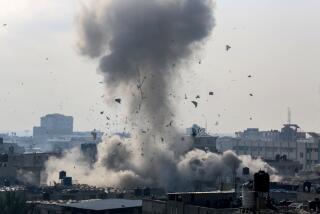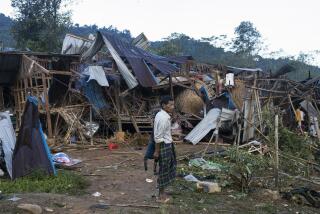Serbs, Croats Agree to Renew Cease-Fire : Balkans: Haggling over Krajina region indicates overall truce is far off.
ZAGREB, Croatia â Serbian rebels and the Croatian government early today agreed to renew a flagging cease-fire to pull back troops and artillery in their suspended war for control of the contested Krajina region.
The agreement came after nearly 18 hours of talks at the Russian Embassy in Zagreb, the Associated Press reported. The haggling over what will be largely a symbolic first step toward reuniting ethnically divided Croatia indicated that an overall peace settlement remains far off.
The cease-fire is to take effect at 9 a.m. local time Monday.
U.S. and Russian diplomats mediating the talks between the Balkan warâs original adversaries had pushed hard for the truce in hopes of adding to the momentum that has halted the shelling of Sarajevo and reunited Croats and Muslims in Bosnia-Herzegovina.
While the two sides--which have waged an on-again, off-again battle for the disputed Krajina region--formally signed the truce, first proclaimed more than two years ago, both held fast to intransigent positions that virtually exclude a peaceful conclusion.
Earlier, Croatian President Franjo Tudjman said that he will resort to a military offensive if the current U.S.-Russian diplomatic effort fails to restore his rule over Krajina. He contended he would have the support of the international community to do so.
âIf they fail to agree, Croatia, in accordance with the relevant (U.N.) Security Council resolutions concerning the integrity of its territory, could resort to other means, and in that case it would have on its side the rest of the world,â Tudjman said of the Serbian rebels who have seized one-third of this country.
Asked if by âother meansâ he was alluding to armed forces to recover Serb-held territory, Tudjman replied, âUltimately, yes.â
He also took pains to identify Croatiaâs 600,000 Serbs as a minority with fewer rights than the Croatian majority and no claim to territorial autonomy from Zagreb.
For their part, the Serbs showed up in the military uniforms of their self-proclaimed independent Republic of Serbian Krajina to underscore their refusal to be considered any part of Croatia. They also insisted on poring over each of 34 detailed maps of the proposed U.N. deployment areas, arguing over every inch of the cease-fire line in apparent expectation that it would eventually become the permanent boundary of their rogue state.
Krajinaâs Serbs are plagued by infighting. But all rebel factions support independence and eventual inclusion of their captured territory in a Greater Serbia.
The detailed marking-off of the current confrontation lines was meant to provide a starting point from which both sides could pull back their troops by 1,000 yards and their heavy artillery by six miles.
But there is little muscle in the agreement wrestled out of the reluctant parties. That leads some observers to fear that neither side will make much effort to abide by the withdrawal provisions.
The cease-fire and separation of forces are aimed at providing breathing space for two more crucial phases of negotiations.
Mediators from the United States, Russia, the 12-nation European Union and the United Nations next want the combatants to restore transport and telecommunications links to build confidence between the rival communities.
They then hope to work out a political settlement that would return Serb-held areas to Croatian government control, in exchange for some degree of autonomy for the Serbs.
Serbs rebelled against Croatiaâs June, 1991, declaration of independence from Yugoslavia and seized one-third of the country in a six-month war that was put on hold in January, 1992, by a U.N.-mediated cease-fire. More than 14,000 U.N. troops have been deployed to the contested region.
More to Read
Sign up for Essential California
The most important California stories and recommendations in your inbox every morning.
You may occasionally receive promotional content from the Los Angeles Times.











